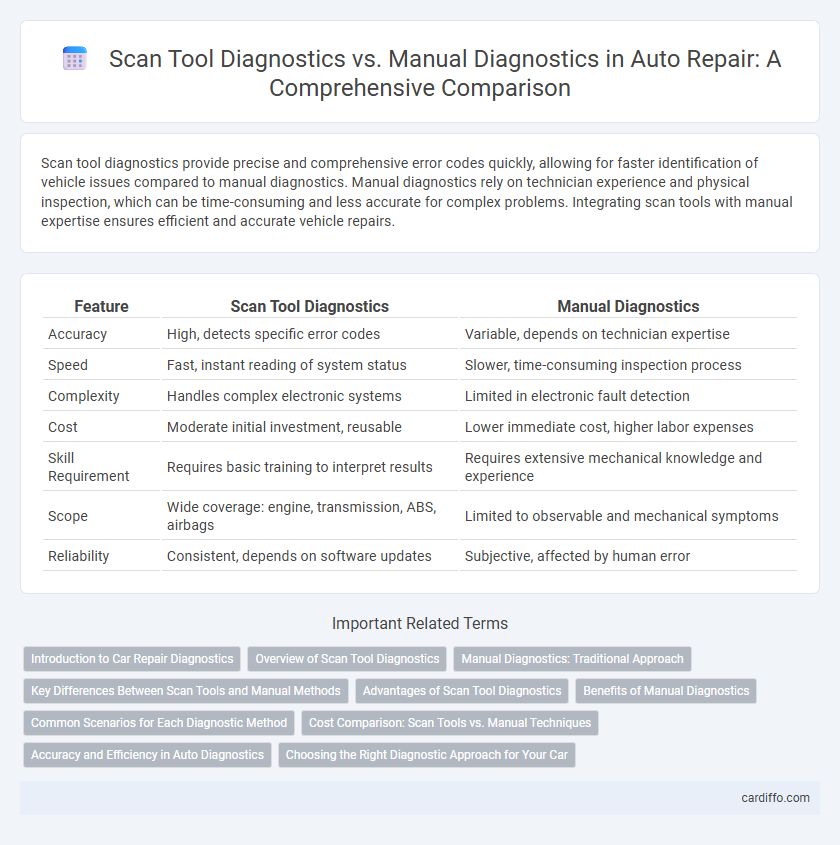Scan tool diagnostics provide precise and comprehensive error codes quickly, allowing for faster identification of vehicle issues compared to manual diagnostics. Manual diagnostics rely on technician experience and physical inspection, which can be time-consuming and less accurate for complex problems. Integrating scan tools with manual expertise ensures efficient and accurate vehicle repairs.
Table of Comparison
| Feature | Scan Tool Diagnostics | Manual Diagnostics |
|---|---|---|
| Accuracy | High, detects specific error codes | Variable, depends on technician expertise |
| Speed | Fast, instant reading of system status | Slower, time-consuming inspection process |
| Complexity | Handles complex electronic systems | Limited in electronic fault detection |
| Cost | Moderate initial investment, reusable | Lower immediate cost, higher labor expenses |
| Skill Requirement | Requires basic training to interpret results | Requires extensive mechanical knowledge and experience |
| Scope | Wide coverage: engine, transmission, ABS, airbags | Limited to observable and mechanical symptoms |
| Reliability | Consistent, depends on software updates | Subjective, affected by human error |
Introduction to Car Repair Diagnostics
Scan tool diagnostics provide precise, real-time data from a vehicle's onboard computer system, enabling faster identification of faults compared to manual diagnostics. Manual diagnostics rely on technician expertise, visual inspections, and physical testing, which can be time-consuming and less accurate for complex modern vehicles. Integrating scan tool data with manual methods enhances diagnostic accuracy and reduces repair time.
Overview of Scan Tool Diagnostics
Scan tool diagnostics use advanced software to quickly identify vehicle issues by interfacing with onboard computer systems, providing real-time error codes and system data. This technology enables precise fault detection, reducing labor time compared to manual diagnostics, which rely on physical inspection and technician expertise. The increased accuracy and efficiency of scan tools make them essential for modern vehicle repair processes.
Manual Diagnostics: Traditional Approach
Manual diagnostics relies on skilled technicians using experience and intuition to identify vehicle faults without automated scanning tools. This traditional approach allows for hands-on inspection and real-time problem-solving, often detecting subtle issues that scan tools might overlook. Expertise in manual diagnostics enhances accuracy in complex repairs where sensor data alone is insufficient.
Key Differences Between Scan Tools and Manual Methods
Scan tool diagnostics offer precise, real-time data by interfacing directly with a vehicle's onboard computer system, enabling efficient fault code retrieval and system performance analysis. Manual diagnostics rely on technician expertise and physical inspection, often requiring more time to identify issues without access to electronic fault codes. The key difference lies in scan tools providing immediate, data-driven insights while manual methods depend on hands-on testing and experience.
Advantages of Scan Tool Diagnostics
Scan tool diagnostics provide precise fault codes that enable faster identification of vehicle issues compared to manual diagnostics, reducing error and guesswork. These advanced tools access real-time data from multiple vehicle systems simultaneously, improving accuracy in detecting complex problems. Utilizing scan tools enhances efficiency in repairs, saving time and labor costs while ensuring thorough assessments.
Benefits of Manual Diagnostics
Manual diagnostics offers in-depth insight based on technician expertise, enabling the identification of complex, context-specific vehicle issues that scan tools might overlook. It allows for real-time feedback and hands-on assessment of mechanical and electrical components, ensuring precise troubleshooting beyond generic error codes. This approach enhances repair accuracy, reduces dependency on technology, and supports tailored maintenance strategies.
Common Scenarios for Each Diagnostic Method
Scan tool diagnostics efficiently identify electronic system faults such as engine misfires, sensor failures, and transmission issues by accessing real-time data and error codes. Manual diagnostics excel in detecting mechanical problems like leaks, worn components, and unusual noises that require physical inspection and hands-on testing. Combining both methods ensures comprehensive troubleshooting in complex vehicle repair scenarios where electronic and mechanical systems interact.
Cost Comparison: Scan Tools vs. Manual Techniques
Scan tool diagnostics typically involve higher upfront costs due to the price of advanced diagnostic equipment, but they significantly reduce labor time and improve accuracy, resulting in lower overall repair expenses. Manual diagnostics may have lower initial costs since they rely on technician experience and basic tools, yet they often lead to longer diagnostic times and increased chances of errors that can increase repair costs. Investing in scan tools enhances efficiency and cost-effectiveness by minimizing diagnostic errors and expediting vehicle repair.
Accuracy and Efficiency in Auto Diagnostics
Scan tool diagnostics provide higher accuracy and efficiency in auto diagnostics by quickly identifying error codes and system malfunctions that are often missed in manual diagnostics. These advanced tools access real-time data from vehicle sensors, enabling precise fault detection and reducing diagnostic time significantly. Manual diagnostics rely heavily on technician experience and can be time-consuming, increasing the risk of misdiagnosis and prolonged repair periods.
Choosing the Right Diagnostic Approach for Your Car
Choosing the right diagnostic approach for your car depends on the complexity of the issue and your technical expertise. Scan tool diagnostics provide accurate, real-time data from the vehicle's onboard computer systems, enabling faster identification of electronic and sensor-related problems. Manual diagnostics rely on hands-on inspection and experience, making them ideal for older vehicles or issues not detected by scan tools.
Scan tool diagnostics vs manual diagnostics Infographic

 cardiffo.com
cardiffo.com